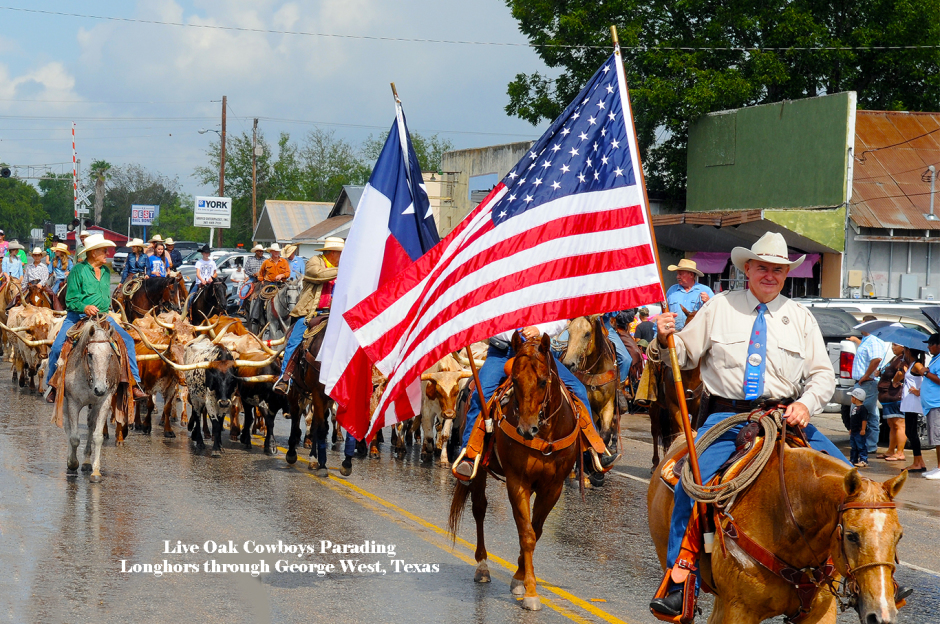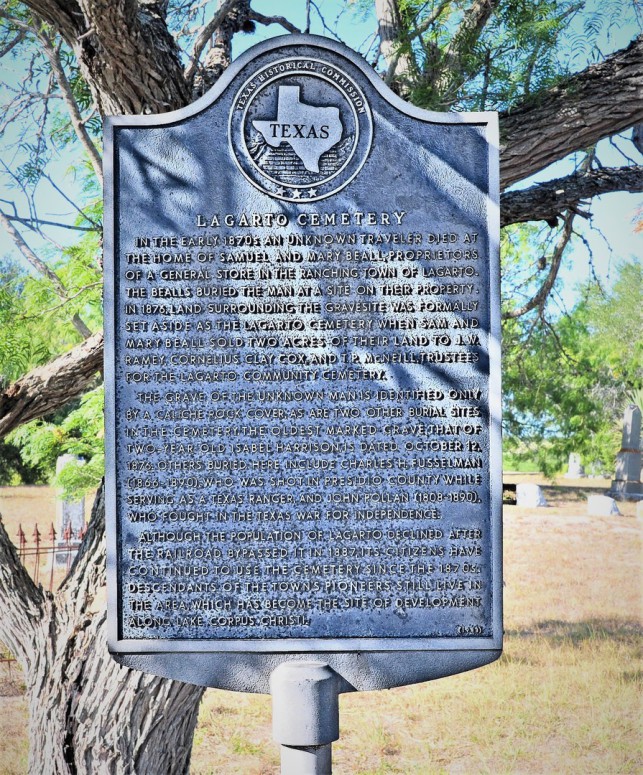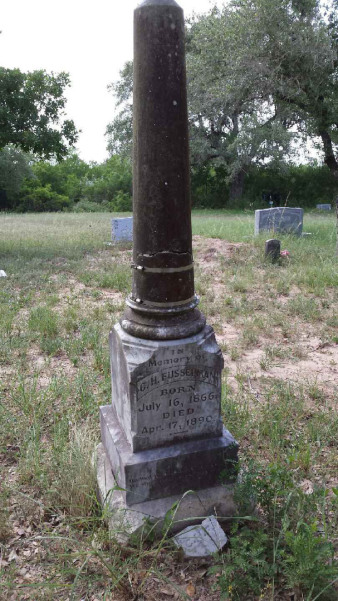
Lagarto Historic Texas Cemetery
Lagarto Cemetery is among the oldest cemeteries in Live Oak County and was the first cemetery in Live Oak County designated as a Historic Texas Cemetery by the Texas Historical Commission. Lagarto Cemetery still has an active cemetery association that meets regularly [2018]. Volunteers for refurbishing needed; contact Marker Chair. Photo courtesty Richard Hudson.
This Texas Hero Obelisk in the Lagarto Historic Texas Cemetery marks the grave of Charles Henry Vanvalkenburg Fusselman (1866-1890). Fusselman, now in the Texas Ranger Hall of Fame, was deptutized a U.S. Marshall in El Paso, Texas when word arrived of a raid by cattle rustlers on a ranch in the Franklin Mountains. Charlie was shot and killed by one of the bandits. Fusselman's body was shipped back to his family in Lagarto. The Pass in the Franklin Mountains where he was shot is named "Fusselman Canyon" and has a Texas State Historical Marker in his honor.
John R. Hughes, Fusselman's friend and Ranger Captain, avenged Fusselman's death when he traded fugitives with Pat Garrett. Found guilty on January 5, 1900, Geronimo Para was then hanged. Photo courtesy Virginia Horton.
Live OaK County Judge: Honorable Bill Kendall
Live Oak County Historical Commission Chair: Jessie Hinnant. S.T. Brown, Jr.
Lagarto Cemetery Sponsor: Lagarto Community Cemetery Association
Lagarto Cemetery Narrative: Lena Beall Porter (1983) [This same narrative used when the THC first awarded Historic Texas Cemetery titles to one of each 254 counties. Lagarto was chosen as the first cemetery in Live Oak County to receive this award on October 2, 2007.]
Date Unveiled: 1983
Lagarto Historic Texas Cemetery Text:
Lagarto Cemetery
In the early 1870's an unknown traveler died at the home of Samuel and Mary Beall, proprietors of a general store in the ranching town of Lagarto. The Bealls buried the man at a site on their property. In 1876, land surrounding the gravesite was formally set aside as the Lagarto Cemetery when Sam and Mary Beall sold two acres of their land to J.W. Ramey, Cornelius Clay Cox, and T.P. McNeill, trustees for the Lagarto Community Cemetery.
The oldest marked grave, that of two year old Isabel Harrison, is dated October 12, 1876. Others buried here include Charles H. Fusselman (1866-1890), who was shot in Presidio county while serving as a Texas ranger, and John Polla (1808-1890), who fought in the Texas War for Independence. Although the population of Lagarto declined after the railroad bypassed it in 1887, its citizens have continued to use the cemetery since the 1870s. Descendants of the town's pioneers still live in the area, which has become the site of development along Lake Corpus Christi. (1983) Marker is the property of the State of Texas.
APPLICATION NARRATIVE and BIBLIOGRAPHY FOR OFFICIAL TEXAS HISTORICAL SUBJECT MARKER:
Lagarto History
The frontier town of Lagarto lies beneath a tangle of thorn bush, prickly pear, lacy mesquites, crumbling rock chimneys and cracked underground cisterns, all of it overlaid with years of caliche dust and memories.
It is nestled in the arms of Lagarto Creek which lends a semi-tropical atmosphere. Lagarto Creek flowed until 1880 and was inhabited by numerous alligators which gave the town the Spanish name.
It seems that the Indians, as early as 1458, found it a pleasant place for a village for the Comanche and Lipan tribes. Proof of attempts at colonization by the Spaniards in 1831 stands in the ruins of Fort Ramirez on the Ramireña Creek. In 1835 Lagarto was a Mexican Pueblo. Jacales made with thatched roofs and dirt floors were their homes built along a creek on the Steadman place southwest of the town square. Mr. Steadman named his place "Sunnyside". It was named "Sweet Hollow" later by H.B. Newberry for the sweet, yellow berries found growing along its banks.
In 1850, Fort Merrill, named for Hamilton W. Merrill of the U.S. Dragoons was established on the right bank of the Nueces River to keep down the Indian raids in the area. It was disestablished in 1855.
In 1851 the last Indian fight between the Indians and soldiers from Fort Merrill took place on the grounds of Lagarto. The Indians were subdued and in 1856, J. W. Ramey, a saddle tree maker from the Fort came down to Lagarto and laid out the streets of the town around a public square.
In the 1850's people began to come to the area, some were on their way to the California gold rush of 1849. Others were seeking grass for their herds. Many liked what they found and stayed.
The first ranchers in the vicinity were Judge Gilpin of Nova Scotia and Sam Belden of New York, who occupied the ranches of Bel-Den and Carmel that had been abandoned by Mexicans who had returned to Mexico because of raids by bandits and Indians. C. C. Cox bought a ranch on the Nueces River from Sam Belden and named it El Colima. Mr. George Wright lived up the Nueces River at Dinero. Captain Dix lived on Loma Prieta Ranch. Charles Russell also lived in the area. Colonel and Mrs. Mann lived on Casa Blanca Ranch. Mr. Mitchell was a Presbyterian minister who preached for this small congregation. There, Milton Dodson, Juan Vela, J. M. Grover, Peyton McNeill and Mr. Swearingen owned ranches along the Nueces River. Sterling Neblin Dobie, Sr. came from Buffalo Bayou to Lagarto Creek in 1858 and built his house of elm trees growing on his place which he put together with wooden pegs. This ranch is now known as the McWhorter Ranch. Robert Dobie and Neville Dobie also came to Lagarto from Sussex County Virginia. James Wrather came in 1866 and built a store of lumber. William Wrather came in 1873 and settled near Dinero. In 1859, S. G. Miller came from North Carolina and when he saw the Nueces Valley decided that there he would pitch his tent. In 1870 he married Miss Susan East of Louisiana and began to develop the Miller Ranch.
In 1850 John Hinnant came from Belmont in Gonzales County to Cayman Lake, located between Bluntzer and Old San Patricio, with Mr. Littlefield, a cattleman. Mr. Hinnant stayed in the Lagarto area. His ranch was Los Picachos northwest of Lagarto. Henry Monroe Hinnant (Tobe) and King Hinnant came with Mr. John Hinnant. Henry Monroe Hinnant married Mary Ann Adams, daughter of Robert and Sarah Adams who came from England in 1852. Mary Ann was born December 14, 1855 in Corpus Christi. In 1956, at the Live Oak County Centennial, when she was 101 years of age, she reigned as Queen of the Brush Country. She lived to be 108 years old.
In 1856 Live Oak County was formed and three residents of Lagarto were chosen as officials: Captain C. C. Cox was County Judge, Frank Church was County Clerk, and J. W. Ramey was the Peace Officer.
In 1870 Samuel and Mary Beall moved from Spring Creek to Lagarto and built their home. The town grew and by 1880 it boasted a bakery, a saddle shop, wagon yards, several general stores, two hotels, boarding houses, a cotton gin, a boot shop, a saloon and a college. The first newspaper, The Echo, was published by Clarence McNeill. It ceased publication in 1866. In 1881 Sydney Cox was editor of the Lagarto Times.
The first schoolhouse was built at the junction of Sweet Hollow and Lagarto Creek by Sterling M. Dobie Sr. and George Wright. Later it was moved to College Hill.
In 1884 stock was sold and certificates were sold for money to build a college for Lagarto; seven to eight teachers were employed. W. Y. Taylor was the first Superintendent; Mr. Cole, possibly the second. Professor Faupel was the music teacher. Miss Ella Jane Byler, who became Mrs. Richard Dobie, mother of J. Frank Dobie, was a teacher in the College. After 1895, Peyton McNeill bought the edifice and moved it to Dinero and converted it into a home. In 1876 Lagarto boasted two churches, the Methodist and the Christian Church. The first Methodist preacher was Rev. H. S. Lafferty and by 1890 the Methodist had 200 members. Dr. Tucker, another Methodist preacher, was one of the first circuit riders and Bro. A. J. Bush, of the Restoration Movement, was the preacher for the Church of Christ which was later known as the Christian Church. The Christian Church was moved to Mathis and made ready for worship services in 1890. The Methodist building remained until 1929 when it, too, was moved to Mathis.
In 1887 when the San Antonio-Aransas Pass Railroad extended its line south to meet the Texas-Mexican Railroad, the ranchers at Lagarto were slow to sell or give their land for the right of way for the railroad, and Mr. Henry Thomas Mathis of Henry Bend Ranch gave the right of way from Tynan to the· Nueces River and the railroad missed Lagarto by eleven miles.
Mr. Mathis dedicated the 300-acre town site in 1889.
A depot was built at Mathis and in Alice. As soon as the railroad approached Mathis, Mr. Ramey, his son, and Mr. H. B. Newberry brought meat and other supplies from their stores in Lagarto.
By 1890, an exodus began from Lagarto to Mathis. Many moved their homes and businesses across the Nueces River Bridge ten miles to Mathis where business was bustling.
The Ramey’s tore down their house and rebuilt in Mathis. Mr. H. B. Newberry moved his two-story house over to Mathis, intact, and placed it on Front Street.
Meanwhile, Lagarto began to slowly dwindle. By 1918 there were a few families left in the community: The Gressetts, the J. E. Wrens, the J. A. Adams, The Sam Cooks with Missess Chaney and Zerapha Cook, the Neville Dobies, Nancy Goodwin and Jack Goodwin, the Sam Bealls, the William Daviss, Lee Hobbs, the A. L. Gooleys, the John Fusselmans, the W. Kolbs on the Valley Ranch, the J. A. Stewarts of the Cartwright Ranch, the Freeman McWhorters on the McWhorter Ranch, the Roy Hinnants, Mrs. M. A. Hinnant and Willie of Los Picachos Ranch, the Jacksons, and the Frank Brandish families.
Sterling Dobie, still in uniform from World War I, taught in the one room school house near the town square. He was followed by Miss Alice Gressett who taught there in 1920. Others who taught were Miss Betty Lou Montgomery and Miss Triptoe.
A new school building was built on the old college site in 1926 by Freeman McWhorter. Joe and Mary Craig Brown were the first teachers to build a home next to the new building. The first teachers who taught in the new building were Tumlinson, Miss Lola Lindsey, and Miss Louise Wilson. Miss Betty Lea Montgomery and Miss Triptoe also. Mrs. Clem Robinson was the last teacher to hold the position before the children were bused to George West.
In 1920 the post office was in the home of Miss Zerepha Cook. Mr. and Mrs. F. H. Booth owned a grocery store. After a few years, Mr. Booth sold his home and the store to Miss Zerepha Cook and her sister, Miss Chaney [Cook], who moved into the Booth house and moved the post office into the store. Miss Zerepha was the last postmaster in Lagarto. She died in 1945.
Some of the early postmasters in Lagarto were: Frank Church in 1874, Cornelius C. Cox in 1877, Harmon Steadman in 1882, and Mollie Steadman in 1885.
Through the efforts of Mrs. Jessie Hinnant, Chairman of the Live Oak County Historical Committee, an historical marker was unveiled on the old college site on October 7, 1967. Dudley B. Dobie, a native of Lagarto, was guest speaker for the dedication ceremony. Special guests were descendants of the College Board of Directors. [While credit is given here to Jessie Hinnant, THC record show S.T. (Tige) Brown, Jr. as LOCHC Chair who signed text approval and receipt for marker when delivered. Jessie may well have been the chair who ortiginated this effort; therefore, credit is given above to her and to Tige.]
Frank Beall 's general store was the last in Lagarto to close. He died in 1953.
In 1957 work to raise the Wesley Seale Dam on the Nueces River near Mathis to the ninety-four-foot level was about to be completed, when events began to take place which would revive old Lagarto.
That year Mr. & Mrs. D. B. Miller gave one hundred thirty and eight tenths acres (130.8) of land on the Nueces River for an encampment for the youth of South Texas. The site overlooks the Nueces Valley on the west bank of the lake. [Known as Camp Zephyr today, 2018.]
Although the words, "The Old Town of Lagarto”, wakes happy memories of life in a frontier town, it is the Old Lagarto Bridge, the magic carpet that transported one across the Nueces River into the town, that remains in the hearts of many. The bridge had spanned the Nueces River since 1870. "Just a short walk from Lagarto" was the way the late Ruth Dodson wrote of it.
The giant oak trees, draped in great sways of silver Spanish moss, stood on either side at the ends of the bridge. Their dense shade welcomed the tired traveler and provided shelter for school and family picnics, even for camp meetings which were held there in the summer.
In 1959 when progress decreed that the gates of the new dam were to be closed, the waters rose and choked the giant trees which drowned in the flood waters.
The faithful old bridge with its steel superstructure was cut from its moorings and dropped into the channel of the river. There it lies buried, the last ghost of the ghost town.
The waters of the Lake became the force of regeneration that made Lagarto live again. In 1957, 1958 and 1959, real estate firms were busy in laying out subdivisions around the lake. On the west side, Mr. Freeman McWhorter was the first to survey camp sites. After that, many subdivisions were opened. Pernitas Point and Barban Estates were taken from the Wade Ranch property. Carmel Hills and Indian Cove were cut from the H. D. Miller Ranch. Porters', on the bend in Lagarto Creek, is a part of the Valley Ranch. From the D. B. Miller Ranch, on Addison Bend, the Arrowhead Subdivision was formed. Camp Bell came from the Lonnie Jennings Estate and the Zephyr Baptist Encampment was a part of the D. B. Miller Ranch.
Mack and Lea Blinka opened Lagarto Store in 1957. A mini-market opened on Arrowhead, also a restaurant, a cafe at Camp Bell, the Arrowhead Country Kitchen, Lagarto Auto Parts, Edsel Lee's Store on FM Road 534, the Flying Missionary School at Arrowhead, Club 534 and the Boat Shop. They all are places of business in the Lagarto Community.
In 1876 Lagarto boasted two churches, the Methodist and Christian Church; both with large memberships. While now, in the Lagarto Community, they number six: Lake Corpus Christi Community Church, Arrowhead Airport, West Shore Baptist Chapel, Lake Baptist Chapel, Corpus Christi Abbey, and Our Father's House.
When Mrs. Jessie Hinnant, of Los Picachos Ranch, saw the host of wonderful women who had moved into the community, she organized a Home Demonstration Club at her home on March 19, 1970. Twenty-nine ladies were present, and Miss Harriet Padelocki, Live Oak County Home Demonstration Agent, gave the program. Their first project was the renovation of the Lagarto School Building for a meeting place. After it was completed, the name was changed to "11 Lagarto Community Club". Other projects include the annual Easter Sunrise Service and the monthly High Blood Pressure Clinic.
In 1865 Emoline Cook Wright was the first to be buried in Lagarto. Her grave is about one-hundred yards northwest of the present schoolhouse.
The cemetery began in 1876 after Samuel and Mary Beall sold two acres of land on a hill north of their home, to J. W. Ramey, T. P. McNeil, and C. C. Cox who were trustees for the Lagarto Community Cemetery.
On January 17, 1981, the Lagarto Cemetery Association was organized with seventeen members present: Harvey B. Newberry was elected President; Lena B. Porter, Secretary; and Hattie Mae New, Treasurer. Dudley R. Dobie, Jr. of Houston was instrumental in securing a charter for the organization.
On May 10, 1982 Lagarto continues to grow - at present there are seven hundred who vote in Lagarto.
Lena B. Porter
(Handwritten at end of application & narrative)
Addition to Lagarto Cemetery history-Connections to Meir Expedition's white and black bean legacy.
Goodwin:
A history of Lagarto would not be complete without the legendary story of Uncle Billy Goodwin and his participation in the expedition to Mier in Mexico led by Capt. Lee Hall of the Texas Rangers, which ended in many of the soldiers being captured and put into prison.
A guard brought a pitcher of black and white beans and each soldier drew one. Those who drew the white beans were released and those who held black beans were to be executed. Uncle Billy drew a white bean and was allowed to return home.
However, there was a young prisoner with no family who gave his white bean to a man who had a family at home. The young prisoner was willing to take the black bean and give his life for his friend.
[The Rathke family in another part of the county had passed this story of their ancestor, the father to whom the white bean was given in order that he might go home to his family, down for generations. However, until they received notice from the above post in 2017, they had not known of this corroborating story from Uncle Billy Goodwin.]
Thanks to Jennifer McWilliams, Cemetery Director, Sarah McClesky, and Bob Brinkman, Director at the THC Marker Archives in Austin for sharing this narrative and folder information.


